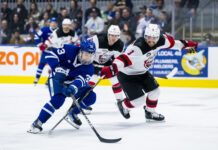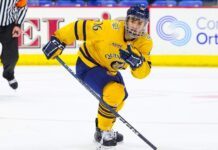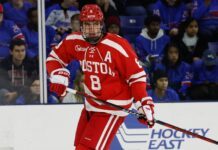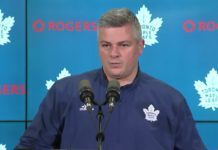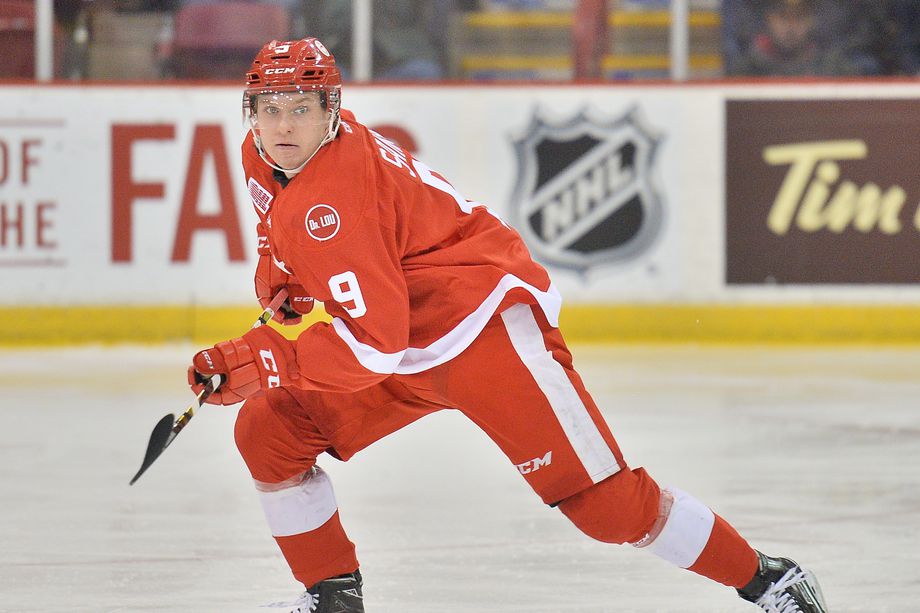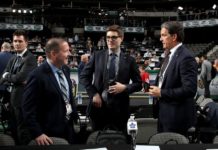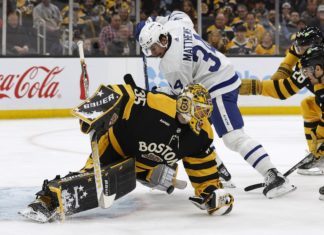Entering the 2018 NHL Draft, the Toronto Maple Leafs’ 25th overall selection represents the latest they’ve ever picked in the draft order with their own first-round draft choice (Alex Steen, Brad Boyes and Luca Cereda were all 24th overall picks).
That means the draft itself packs a little bit less intrigue from the Leafs perspective, but the organization has no shortage of picks (seven) and it will be intriguing to monitor how the draft philosophy might shift under new General Manager Kyle Dubas, who will be running the draft with input from his regional scouting directors and his assistant General Managers sans the departed Mark Hunter.
The natural tendency among the fan base is to hone in on the right-handed defensemen — and defensemen in general — available due to the needs of the big-club currently, but Dubas’ definitive “Best Player Available” commitment has made it pretty clear that the big club’s roster is not going to factor into the decision-making process at the draft when it comes to projecting players 3-5 years away from breaking through at the NHL level (nor should it).
Talk of trade-down scenarios and draft pick value charts are natural discussion points after the manoeuvring witnessed at the Hunter and Dubas-run 2015 draft, but if you listen to Dubas himself, no scenario – trade down, trade up, stand pat — is off the table entering into tonight in what seems like a particularly wide open Round 1 after the top two picks.
Assuming the Leafs stand pat, here are a few potential options to mull over at #25. Add your thoughts on potential candidates in the comments below.
Potential Options at #25
Ryan Merkley (RHD) – The offensive skillset is overflowing with the Guelph Storm defenseman, but so too are the question marks about his defensive game and character/intangibles. The OHL leader in primary assists this season among defensemen as a 17-year-old sophomore, Merkley is a dynamic offensive talent with fantastic all-range skating ability, offensive vision & instincts, and a high-end shot off the blue line. Merkley’s level of engagement defensively can waver throughout a game and he cuts something of a lightning rod figure. The numbers are undeniable: Merkley racked up 67 points in 63 games in his draft year after tallying 55 in 62 as a 16-year-old rookie in 2016-17. One of the intriguing storylines in the second half of the first round is which team is going to swing for the fences on Merkley’s upside despite the question marks and risk factors. Could go as high as 10th or fall much later.
Ryan McLeod (C) – Brother of 2017 New Jersey first rounder Mike McLeod, then-Steelheads GM James Boyd, in an with MLHS last summer, contrasted Ryan’s game with his older sibling’s: “If Mike is going to barge down the front door, Ryan is going to find a way through the side door.” McLeod is a skilled playmaking center with solid size (6’2, 205), a good motor and an ability to drive play, but he has faced criticism for his reluctance to shoot and a tendency to stay on the outside of the offensive zone instead of driving inside the dots. After missing last year’s draft cutoff by a week, McLeod finished the season with 70 points in 68 games and added five in six games in the Steelheads’ first round playoff exit.
Rasmus Sandin (LHD) – The connections to the Leafs here come naturally, with the Sault Ste. Marie Greyhounds tie to Leafs GM Kyle Dubas, who likes the mobility and intelligence in Sandin’s game. When asked in a TSN interview about Craig Button’s mock draft pick of Sandin for the Leafs, Kyle Dubas said Sandin, “plays defense the way I like it to be played – very, very good with the puck, skates very well. In the playoffs for the Soo, he took his game physically to another level and showed a great level of competitiveness in addition to his skillset. If Craig were the GM of the Leafs and he made that pick, it’d be a good pick.” Sandin finished his rookie OHL season with 45 points in 51 regular season games after arriving from Sweden in the 2017 import draft, and played big minutes for the Soo with Conor Timmins away at either the World Juniors or missing time through injury.
Calen Addison (RHD) – The Lethbridge Hurricane broke out offensively with 65 points in 68 games off of the blue line in 2017-18 — ninth in WHL defense scoring and second among 2018 draft eligibles behind Ty Smith. Undersized at 5’10, 178 pounds, Addison otherwise possesses many of the attributes teams look for in the modern-day defenseman – high-end skating ability over all ranges (including an explosive first three strides), high-end puck-moving skills and first-pass ability, and a willingless to battle physically, even if he’s not the biggest kid on the rink. There is a lot of work needed on his defensive game, but the upside here is substantial. With his upside potential and offensive track record, Addison appears to fit what outsiders often consider a “Dubas pick” if he falls to 25.
Bode Wilde (RHD) – The 6’2, 198-pound right-handed defenseman is a gifted athlete with impressive physical tools and significant offensive upside, but he has faced questions about his decision-making, ability to take care of the puck, and his overall hockey IQ. Committed to the University of Michigan for next season, Wilde racked up 16 points in 25 games for the U.S. National Under-18 team in 2017-18. Most draft boards have him gone before the 25th pick (10-20 range), such is the upside here.
Kirill Marchenko (RW) – The 6’3, 187-pound Russian winger finished a disappointing sophomore MHL season on a high by potting seven points in eight playoff games, but his numbers took a significant step back from the 15 goals and 26 points he posted in 29 games last season for Mamonty Yugry. Deceivingly fast despite an awkward skating stride, Marchenko plays a powerful game and owns a good release as well as the skill to make plays. He’s also well regarded for his 200-foot game despite the stereotypes that often follow Russian forwards.
Jay O’Brien (C) – Committed to Providence College, the 5’10, 180-pound right-handed center played prep school hockey for Thayer Academy this past season, racking up 80 points in 30 games this season, including 43 goals. In his USNTDP U18 appearances, he chipped in two points in seven games and garnered positive reviews for his performances despite limited opportunities. Considered a skilled, industrious two-way center that is great on his edges, O’Brien ticks the box on hockey sense big time. He did compete against inferior competition for much of the season and had limited showings to go on with the USNTDP or in international tournaments. Outside shot at breaking into the first round but more likely a second-day pick.
Albin Eriksson (RW) – The lanky, rangy winger (6’4, 207 pounds) owns a heavy shot, which he used to good effect at even strength and on the power play for Skelleftea J20 in the SuperElit league, tallying 22 goals and 40 points in 38 games. Eriksson, who can play both wings, also appeared in 17 SHL games but saw limited minutes in top-flight Swedish hockey, tallying just one assist. Eriksson needs to fill out his frame and build strength in order to add another gear to his skating and fully take advantage of his physical frame. A raw prospect who is just scratching the surface on his potential, he is a bit of a sleeper with a shot of breaking into the first round on Friday night.
Nicolas Beaudin (D) – A highly-productive season saw the 5’11, 175-pound left-shot defenseman finish top-five among QMJHL defensemen with 69 points in 68 games before adding 11 points in 10 playoff games for Drummondville. A high IQ blue liner, Beaudin can run a power play and break the puck out with either his feet or a good first pass. The Chateauguay, Quebec native has come along way with his ability to compete in strength battles in the defensive zone but must continue to make strides in the physical part of the game. Craig Button ranked Beaudin at 20th on his draft board, but he’s slotted much lower on others.
Fillip Hallander (C) – The 6’2, 188 pound forward is a versatile, two-way center/winger who plays a hard-nosed game and isn’t shy about driving the net or playing in traffic. While arguably lacking a standout skill, he has a well-rounded skillset that isn’t lacking in any one area. Hallander spent the season in the Swedish second division competing against men and tallied 20 points in 40 games to help Timra earn a promotion to top-flight Swedish hockey for 2018-19. Hallander also tallied four points in five games at the Hlinka tournament early in the year.
Jacob Olofsson (C) – A teammate of Hallander’s on Timra, the two now sit fifth and sixth all-time in points by a U18 player in the Allsvenskan, with Olofsson just ahead of Hallander (21 points in 43 games), earning him the junior player of the year award in Sweden’s second division. The counterman has the size (6’3, 190), two-way game and well-rounded skill set that should ensure he’s selected inside the first round, although there is some debate about the extent of his upside. He also did not make the best impressions in international tournament appearances this season and battled some consistency issues.
For a full rundown of all of the prospects available in the 2018 draft, check out HP’s Blackbook.














